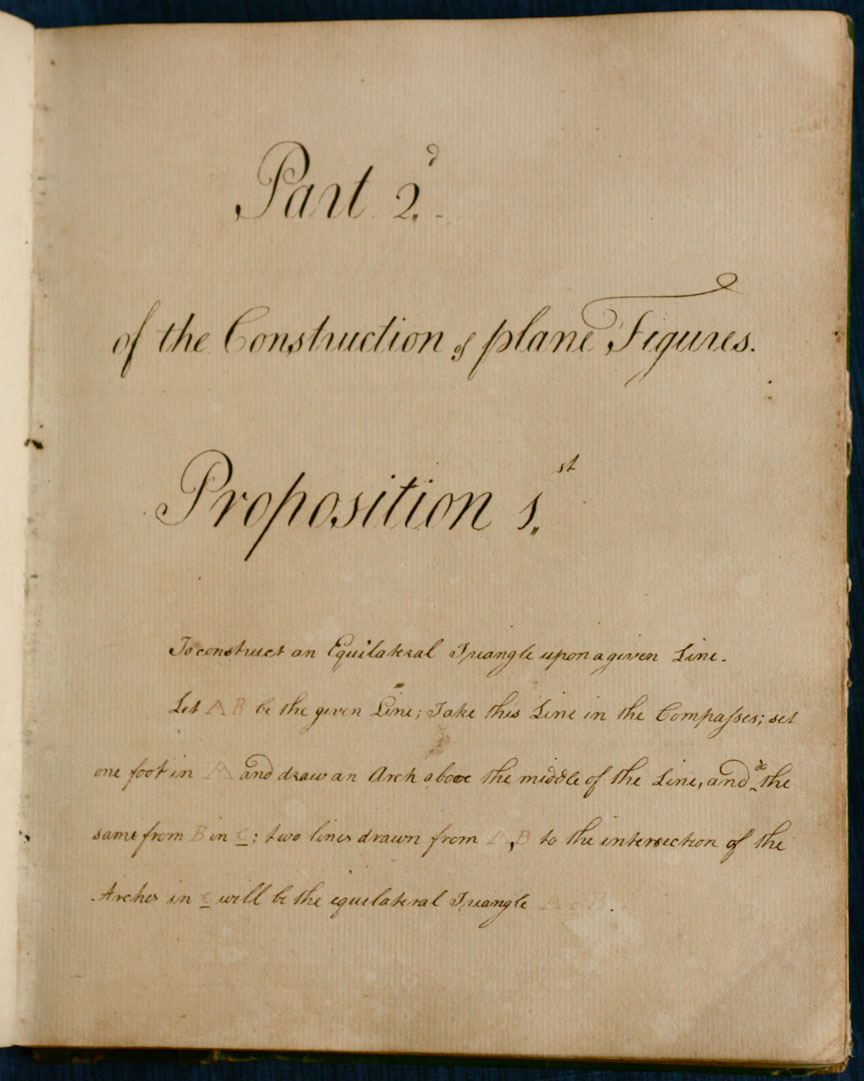- About MAA
- Membership
- MAA Publications
- Periodicals
- Blogs
- MAA Book Series
- MAA Press (an imprint of the AMS)
- MAA Notes
- MAA Reviews
- Mathematical Communication
- Information for Libraries
- Author Resources
- Advertise with MAA
- Meetings
- Competitions
- Programs
- Communities
- MAA Sections
- SIGMAA
- MAA Connect
- Students
- MAA Awards
- Awards Booklets
- Writing Awards
- Teaching Awards
- Service Awards
- Research Awards
- Lecture Awards
- Putnam Competition Individual and Team Winners
- D. E. Shaw Group AMC 8 Awards & Certificates
- Maryam Mirzakhani AMC 10 A Awards & Certificates
- Two Sigma AMC 10 B Awards & Certificates
- Jane Street AMC 12 A Awards & Certificates
- Akamai AMC 12 B Awards & Certificates
- High School Teachers
- News
You are here
Learning Geometry in Georgian England - Master Thomas Porcher
To construct an Equilateral Triangle upon a given Line. Let AB be the given Line; Take this Line in the Compasses; set one foot in A and draw an Arch above the middle of the Line, and do the same from B … two lines drawn from A, B to the intersection of the Arches in C will be the equilateral Triangle ACB.
These lines come from the geometry copybook of a boy named Thomas Porcher. It’s about 61/2 inches by 91/2; it’s bound in green card. It has more than 200 pages, so it’s quite a chunky volume. Thomas wrote it around 1770.

Figure 1. Thomas Porcher constructs an equilateral triangle.
What was it like to learn geometry in Georgian England? It depended very much on who you were and what you were – and hence on why you were learning it in the first place. In this article we’ll look at two examples which show some of the differences between different approaches. But the two young men concerned had one thing in common, at least: they both prepared geometrical copy-books containing a record of what they learned and how they learned it, enabling us to reconstruct something of their geometrical education.
Thomas Porcher was about 14 at the time he wrote his copy-book; he was born in 1756 (the same year as Mozart). His book is a remarkable feat of penmanship: neat, meticulous, and accurate, it must have taken many long hours to do. Porcher’s was a fairly prosperous family, it seems, in Walworth, near London, England. We don’t know much about them, though one of Thomas’s sons, Samuel, would make good in the New World: by 1811 he owned a plantation in South Carolina, which he named Walworth after his family’s home in England. Porcher Avenue in Eutawville, South Carolina was named after the family.
Thomas was probably learning geometry with a tutor. This tidy book isn’t the kind of product that would normally have been created in a school setting, where a bit more chaos usually seems to have ruled.
Benjamin Wardhaugh (University of Oxford), "Learning Geometry in Georgian England - Master Thomas Porcher," Convergence (August 2012), DOI:10.4169/loci003930




